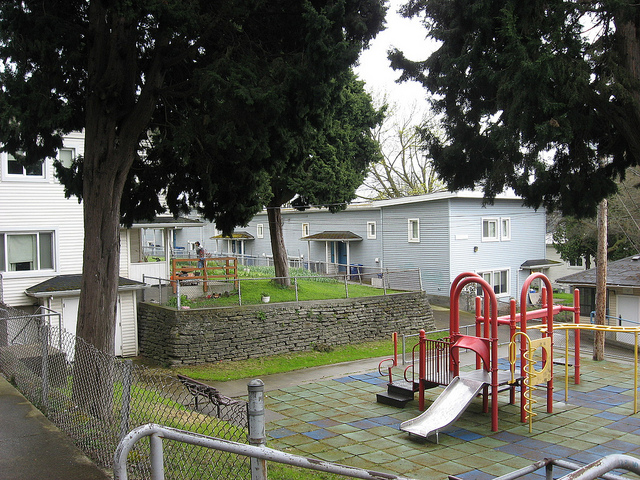
Since 2011, Republicans in the U.S. House have forced through significant cuts to federal spending with the goal of undermining public services. No program has been immune from these cuts, including public housing. At a time when demand for affordable housing is soaring in cities like Seattle, federal austerity has led to hundreds of millions of dollars in cuts to HUD programs. Seattle alone has seen more than $16 million in federal housing cuts since 2011.
This leads cities to make a choice. Find ways to avoid the impact of these cuts, including new revenues, or go along with them and impose their own local austerity policies that make it even harder for residents to find stable, affordable housing.
The Seattle Housing Authority has chosen to embrace austerity. SHA’s new “Stepping Forward” plan would raise rents on current tenants by as much as 400% over five years. The justification, according to SHA head Andrew Lofton, is that it would encourage tenants to get better jobs and make room for new tenants who need affordable housing.
That’s the same argument made by those on the right — and one that flies in the face of lived reality. Although federal austerity will likely be temporary, Lofton’s proposal makes permanent changes to SHA policies, remaking housing policy in a progressive city like Seattle along fundamentally conservative lines.
Lofton’s plan has generated significant protest this week at public hearings. It’s not hard to see why. Here’s how KIRO TV’s Natasha Chen summarized the plan:
Under the draft proposal, rents would instead be tied to the size of the rental unit. The program also includes enhanced education, training, and employment support.
For example, a family might start out paying $160 a month for a two-bedroom unit. That rent would increase to $360 a month the following two years, then $560 for the fourth and fifth years, then $860 for the sixth year. The agency is still determining if there should be any further increases after that.
“The whole point of this is to help people be successful,” said Andrew Lofton, executive director of the Seattle Housing Authority.
Lofton said he believes most people will be successful in getting higher-earning jobs and won’t need assistance anymore. That will make room for more families to receive housing.
This proposal is intended to conform with the federal government’s Moving to Work program, part of the failed 1996 “welfare reform” plan. “Moving to Work” attempts to force public housing to adopt policies that push renters out if they can’t find a job.
It has become clear that “welfare reform” policies like that adopted by a right-wing Congress and signed by President Bill Clinton in 1996 have merely increased poverty across America in the nearly two decades they have been in operation. It’s the same logic used by the right-wing government currently in power in Britain, where a variety of public assistance programs are being curtailed on the theory that doing so forces people to find better jobs. There, as in the USA, the result is greater poverty.
The theory is that if residents are threatened by higher rents or the loss of housing, they’ll be motivated to find better paying work. To her immense credit, Natasha Chen questioned the rosy picture Lofton and other welfare reformers have painted. She quickly discovered that, for most low-income workers in Seattle, moving up the wage scale is extremely difficult:
But in order for a tenant to pay the increased rents, they would have to make about $20 an hour by the fifth or sixth year.
Sylvia Sabon, who raises her grandson on two part-time receptionist jobs, currently gets paid $11.54 an hour.
“I’ve been working half my life, and I have never made $20 an hour,” she said.
KIRO 7 found out from the U.S. Bureau of Labor and Statistics that total compensation in the Seattle area increased by less than 2 percent from June 2013 to June 2014. The year before, the increase was less than 5 percent.
Seattle’s economy is booming, but the benefits are not widely shared. Many Seattleites continue to toil in low-wage jobs, unable to move up even when they receive education or training to help them do so. Contrary to Lofton’s claims, education — while surely important — is no guarantee that a person will find a job at all, let alone one that would allow them to afford the massive rent increase SHA is proposing.
For those reasons alone, “Stepping Forward” should be rejected outright. The proposal is facing increasing political opposition. Mayor Ed Murray sent a letter “expressing concern” over the impact of the proposal. Councilmember Nick Licata has called on the federal government to intervene. Even the Seattle Times has come out against it.
But the discussion should not stop there. Lofton’s regressive proposal raises deeper questions about the role of public housing in a modern city.
Protection from the market
Under the SHA plan, public housing would become a temporary service — there to keep people from the street but not a permanent solution. In this view, renters should be forced back into the marketplace as quickly as possible, regardless of the effect on their household income, and SHA is willing to coerce tenants to do so. Yet that flies in the face of a century of public housing policy in both Europe and North America.
Public housing has traditionally protected the working class from the vagaries of the market. As rents rise, tenants find their household budgets squeezed. Low-income workers have little wiggle room in their monthly budgets. If rent goes up, something else has to give — food, clothing, education, maintenance, or, most likely, discretionary spending that supports the local economy.
Rising rents can cause crisis for a working class family. The cost of moving is not cheap, and neither is the cost of securing rental housing on the market. Coming up with a first, last, and security deposit is particularly difficult. It can be done at the expense of savings, but City policy encourages “asset building” in the form of savings for low-income families.
Public housing, then, acts as a crucial tool to provide lasting financial stability for low-income households. Stable rents below market rates help those families build assets and protect them from a housing market that routinely pushes rents to unaffordable levels during a growing economy.
If the goal of urban policy is to reduce poverty, then the cost of living must correspondingly be contained — permanently. This is why subsidized public housing, subsidized and plentiful public transit, universal free health care, and other similar policies are essential elements of a successful urbanism. You can have urbanism without those tools, but it will be an urbanism of staggering inequality and endemic poverty.
The experience of Europe after World War II and the United States in the same period shows the value of public housing as a tool to reduce poverty. Britain’s council homes provided affordable, quality homes for millions across the nation. Similarly, American public housing was critical in producing significant income growth and poverty reduction in the 1950s and 1960s.
The rent is too damn high
Even if tenants could afford higher rents, it’s bad macroeconomic policy to charge them. Rent is a non-productive economic activity that takes money away from better uses. National economic policy should seek to hold down rents so that tenants can use more of their income on useful things that add value to the community. That could include locally made foods and goods, education, creating new ideas or products, or simply providing more financial security for households at a time when such security is desperately needed.
Lofton’s “Stepping Forward” plan turns public housing into an agent of impoverishment rather than a way to escape it. It is built on flawed assumptions of how the modern American economy works and fails to offer the poor useful, lasting help to afford an increasingly expensive world. If the goal is to provide housing to more people who need it, we must expand the amount of public housing available to meet the need.
Resisting austerity
Given these serious flaws, why would SHA even consider something like “Stepping Forward”? The argument in favor appears to be that it would allow SHA to bring more people into their housing programs and thus deal with the impact of federal austerity.
As shown above, this logic is hard to defend given the damaging impact it has on overall housing affordability and the fundamental purpose of public housing. The proposal pits low-income renters against each other without providing any real benefit. Those who receive housing would be there only because someone else was pushed out by rising rents. New residents will find themselves on the same unaffordable treadmill and in turn lose their home to someone else, having achieved a very brief rent savings only to return to an unaffordable housing market in a city where higher-paying jobs remain elusive. That’s no way to address long-term poverty and housing affordability.
It’s important to keep in mind how right-wing fiscal policies work. Conservatives don’t just want to spend less. They want to change the very nature of government services to follow their own ideological values — ideally eliminating those services entirely. The 1996 welfare reform and the post-2011 austerity cuts serve these broader goals. They’d love to eliminate public housing altogether, as they don’t believe government should subsidize someone’s rent. But that’s considered too politically risky or unattainable. Instead they use the power of the purse to force local housing agencies to start pushing renters out of housing. If progressive cities like Seattle embrace this kind of housing policy, that’s a big victory for conservatives.
We see the same philosophy at play with transit funding. As in housing, conservatives demand service cuts so that fewer people use transit and therefore make it easier to eventually eliminate the service. But they cleverly avoid responsibility for the actual cuts themselves. Instead, they hand progressive cities the knife and force us to decide which limbs we keep and which we cut off. And we often comply, applauding ourselves for finding a clever way to decide how to undermine our values and cut people off from vital services.
What should SHA do instead?
When it comes to dealing with service cuts imposed from outside, the only winning move is not to play. The better option is for SHA to pursue progressive policies that provide cost certainty and stable, lasting, affordable housing for the people of Seattle.
The first step is to seek new sources of funding. Under former mayor Mike McGinn, the City of Seattle backfilled numerous state and federal cuts to public services, including homeless services. The City should work with SHA to find new funding for the 2015-16 budget cycle to provide new affordable, publicly owned housing that doesn’t produce rising rents or force existing residents out of their homes. This should also be part of the work of Mayor Murray’s Housing Advisory Committee. Seattle desperately needs more housing supply, including publicly owned supply.
A longer-term solution is just over the horizon. Seattle’s housing levy will be up for renewal in 2016. That’s a great opportunity to address the impact of federal cuts while expanding the City’s spending on public housing programs, adding supply that provides lasting benefits to low-income households. If “Stepping Forward” is adopted, however, it would negate the impact of any new funding from a housing levy.
“Stepping Forward” is rapidly losing political support. That’s good news, but it will be a short-term victory without progressive steps to obtain the funding that SHA needs to expand its housing supply and help Seattle address the affordability crisis.

Robert Cruickshank
Robert Cruickshank is a transit rider and progressive campaigner who lives in Seattle’s Greenwood neighborhood. From 2011 to 2013 he served as Senior Communications Advisor to Seattle Mayor Mike McGinn.


